Painted Dreams: The Art of Evelyn De Morgan, installation view, Wolverhampton Art Gallery, October 2024. Photograph by Patrick Dandy
Painted Dreams: The Art of Evelyn De Morgan
19th October 2024 – 9th March 2025
Evelyn De Morgan’s ground-breaking 1907 show to be recreated in Wolverhampton
Major show featuring 30 oil paintings and drawings | Beautiful artworks on loan from the Trustees of the De Morgan Foundation and Private Collections reunited after 120 years | Lost paintings painstakingly recreated by local artist | 1907 artworks with themes relevant to 2020s audiences

Luna (1885)
In 1907, Wolverhampton Art Gallery held a retrospective of works by the late Pre-Raphaelite artist, Evelyn De Morgan. It showcased some of her most impressive paintings such as ‘Flora’ (1894) a life-size painting of the Roman Goddess of Spring, and ‘The Storm Spirits’, a picture which imagines thunder, lightning, and rain as beautiful women. The exhibition was a milestone in De Morgan’s career and for female artists as it was the first time a modern gallery dedicated a solo exhibition to a woman. De Morgan’s art was well received, with one reviewer for the Wolverhampton Express and Star describing the pictures as ‘painted dreams’.
The De Morgan Foundation and Wolverhampton Art Gallery have worked together to reimagine De Morgan’s seminal exhibition of 1907 for a contemporary audience. As many of the paintings from the 1907 exhibition as possible have been gathered for the display. These will be presented chronologically over three galleries to give an overview of De Morgan’s artwork and some of the themes she engaged with and returned to across her career.
In 1991, there was a fire at a warehouse where a number of De Morgan’s artworks were stored. Therefore, three pictures included in the 1907 show are impossible to include in this exhibition. Paul Francis-Walker, a local artist working in the Pre-Raphaelite style, has recreated these paintings. This will allow a full discussion of De Morgan’s artistic process and techniques and give the public a deep understanding of her paintings.
Evelyn De Morgan (1855 – 1919)
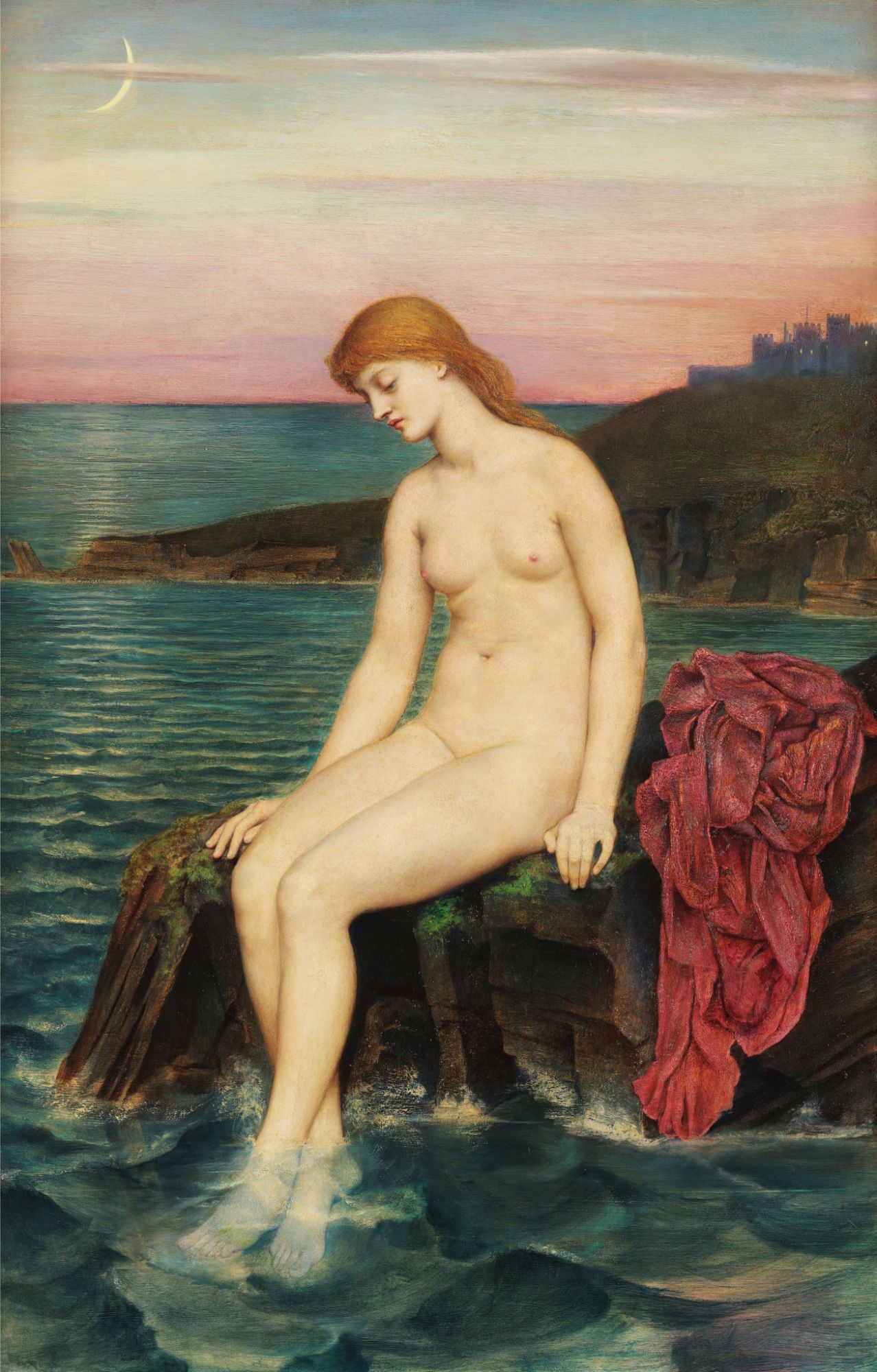
The Little Sea Maid (c.1880)
Mary Evelyn Pickering De Morgan was born in London in 1855 to upper-class parents. One of four children, De Morgan was educated at home and benefitted from private tuition. She wrote original poetry from an early age which explored some of the themes which would later dominate her paintings. Despite some parental resistance, De Morgan was determined to be a professional artist and began training at the National Art Training School before enrolling at the newly formed Slade School of Art at the University of London. It was at this time she began using her unisex middle name, Evelyn, rather than her given name, Mary, so that her work would be judged on merit alongside her male peers, rather than as art by a woman. This gives an insight into the prejudices of the time; being an artist was widely considered a male occupation and unsuitable for a woman.
De Morgan excelled at the Slade, winning a full scholarship for her studies and many prizes for her artwork. She was particularly celebrated for her life drawing and compositions, which is evident in her later paintings. De Morgan was inspired by Italian Renaissance paintings and the work of Botticelli in particular. She travelled to Italy to copy paintings in the Uffizi Gallery in Florence and evidence of Raphael’s majestic colours and Michelangelo’s sculptural forms are found in her artworks, such as The Little Sea Maid.
De Morgan first exhibited paintings in London’s Dudley Gallery in 1876. Featuring St Catherine of Alexandria and the mythological figure of Harmonia, the paintings had popular appeal and were immediately purchased by notable patrons, Lord Henry Somerset, and Sir Charles Dilke MP. As a result, De Morgan was invited to exhibited at the first Grosvenor Gallery exhibition, an exclusive gallery dedicated to avant-garde artists. Her work was admired alongside paintings by celebrated artists such as Edward Burne-Jones, Edward Poynter, and her uncle, Roddam Spencer Stanhope. She continued to submit artworks to exhibitions throughout her career to critical acclaim.
In 1882, De Morgan was introduced to the ceramic designer William De Morgan at a fancy dress ball where she was dressed as a tube of paint. Despite the 16-year age gap, the two artists were aligned in their views and ideas and began dating. They were married some years later in 1887 forming a unique artistic partnership. They enjoyed living in Chelsea, London, a particularly artistic area of the city, and spending winters in Italy until the outbreak of the First World War.
Organising the Exhibition
J. J. Brownsword was curator at Wolverhampton Art Gallery in the early 20th century and set about organising exhibitions which would bring unknown artworks to the region, including a celebrated show of Norwegian artworks in 1913.
On a visit to London, Brownsword stopped off at the ceramic designer William De Morgan’s studio home to view his pottery. What he had not expected was to be so enamoured with paintings made by William’s wife, Evelyn De Morgan, which were shown to him by William.
Unable to forget what he had seen, Brownsword contacted Evelyn De Morgan directly and requested to borrow her artworks for a solo exhibition at Wolverhampton Art Gallery.
“The impression [your paintings] made upon me is still vividly impressed on my memory and the remembrance of the pleasure they gave me prompted me to call at [your home] this week to ask if you would be so kind as to lend your works to the Corporation of Wolverhampton for an exhibition at the Wolverhampton Art Gallery” wrote Brownsword in 1906.
Evelyn De Morgan was pleased to agree, and the exhibition opened in February 1907. Eager to impress, De Morgan wrote to Brownsword shortly after the public opening of the exhibition to thank him for the opportunity and to tell him how pleased she was. She also asked, “perhaps if you have time you will write me word how the pictures look and if people like them”. In this letter, De Morgan reveals some of her anxiety over sharing her pictures in a solo exhibition with a new and discerning modern audience. Clearly, she understood the importance of this exhibition in her career.
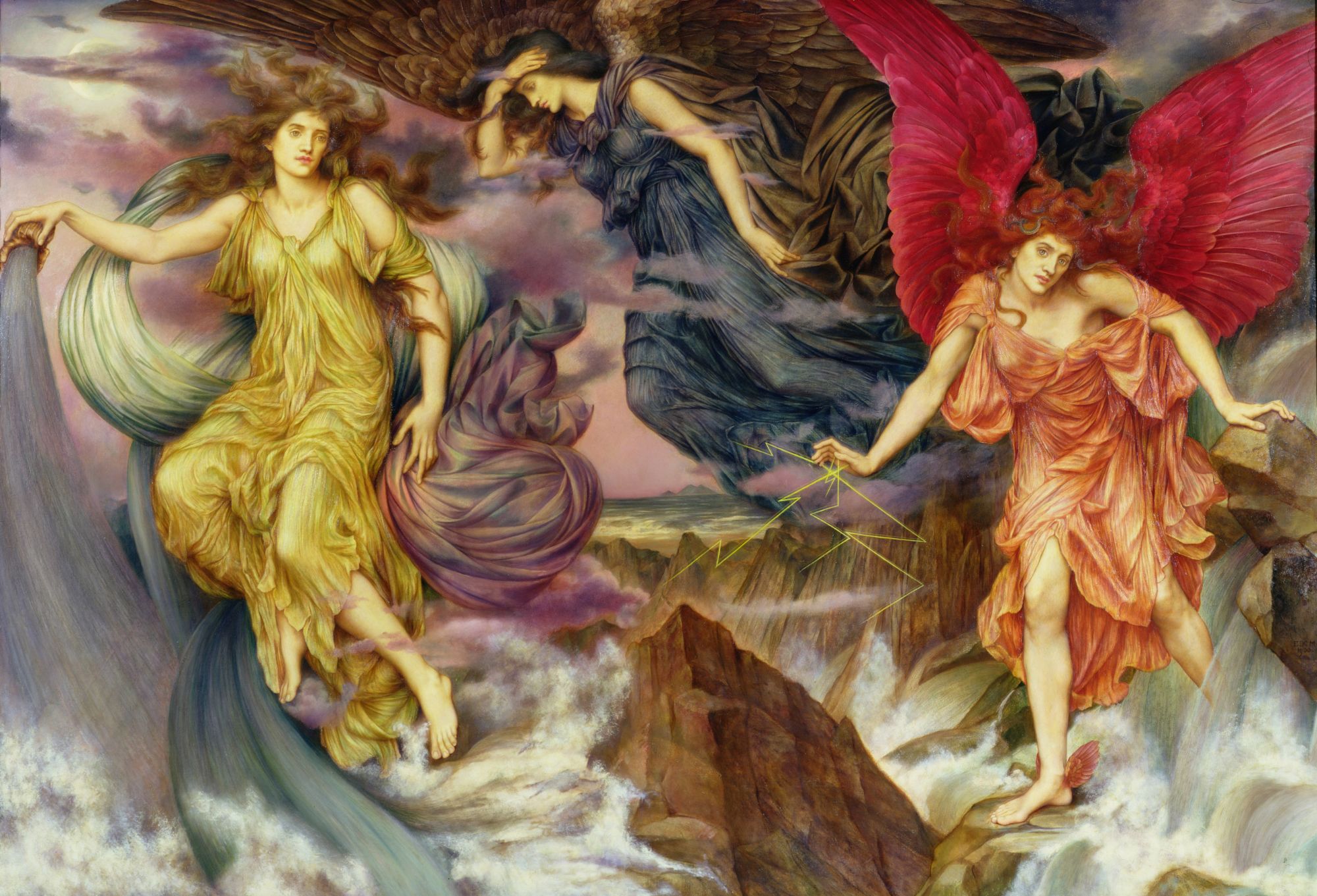
The Storm Spirits (1900)
De Morgan’s Wolverhampton show was the largest and most comprehensive of her career. Moreover, it is unique as a solo exhibition held in a prestigious gallery dedicated to a woman. It is therefore disappointing the so few reviews of this achievement seem to have been written. Perhaps having the exhibition in Wolverhampton rather than the capital impacted the number of reporters who thought it worthy of their attention. It could also be the fact that De Morgan’s art was judged as unimportant due to prevailing gender biases of the time. However, one reviewer writing for the Wolverhampton Star has nothing but praise for De Morgan’s paintings. They are described as having ‘the faces of our dreams’ and De Morgan is complemented for her ‘gift of colour’, something particularly evident in her prismatic piece The Storm Spirits (1900).
This must have been a relief to De Morgan who had recently exhibited some of her paintings in Germany where reviews had been less than complementary. H. Vollmer wrote “Evelyn de Morgan, the pupil of Watts, is a mere imitator of the master, her allegorical compositions display great richness of colour, but otherwise do not arrest the attention through any merits whatsoever; her coming to Germany will gain no new friends for the symbolic direction of her great English teacher.”
Following the Wolverhampton exhibition, ‘Flora’ (1894) a key piece in the exhibition was sold from the Imrie Collection, having been lent by the shipping magnate William Imrie’s daughter. The painting reached 180 guineas at Christie’s, a high sum for the time, suggesting something of the legacy of the Wolverhampton Exhibition.
The 1907 Exhibition Catalogue
A catalogue of the works on display was produced by Wolverhampton Art Gallery and a copy is held in the National Art Library in London. Entitled ‘Special Exhibition of Oil Paintings Evelyn De Morgan (Mrs.) and other Artists’ the catalogue hints at the excitement and sense of occasion felt by the organisers of the exhibition.
The exhibition opened with some of the largest works De Morgan sent, such as The Grey Sisters, Night and Sleep, The Hourglass, and Boreas and Oreithyia. These pictures give a flavour of the themes in the exhibition, from music and literature to mythology. De Morgan’s catalogue note on The Hourglass explains that the painting is ‘an echo of a movement in the Waldstein Sonata of Beethoven’, demonstrating the artist’s deeply poetic and involved process of painting, hitherto unexplored.
Her more ethereal pictures – The Little Seamaid, Luna, and Earthbound – follow, welcoming the visitor to engage with her symbolist style and Spiritualist narrative. De Morgan’s own poem accompanies Earthbound which makes absolutely clear her message that the pursuit of material wealth is a barrier to spiritual fulfilment. It reads
Who clutches at a heap of gold
Still clutches what he shall not hold.
The soul that knows no second birth
Shall wane, fast held by Mother Earth.
Grim twins await his latest breath-Oblivion, hand in hand with death, He sinks, the captive of his prize, Nor even knows that others rise.
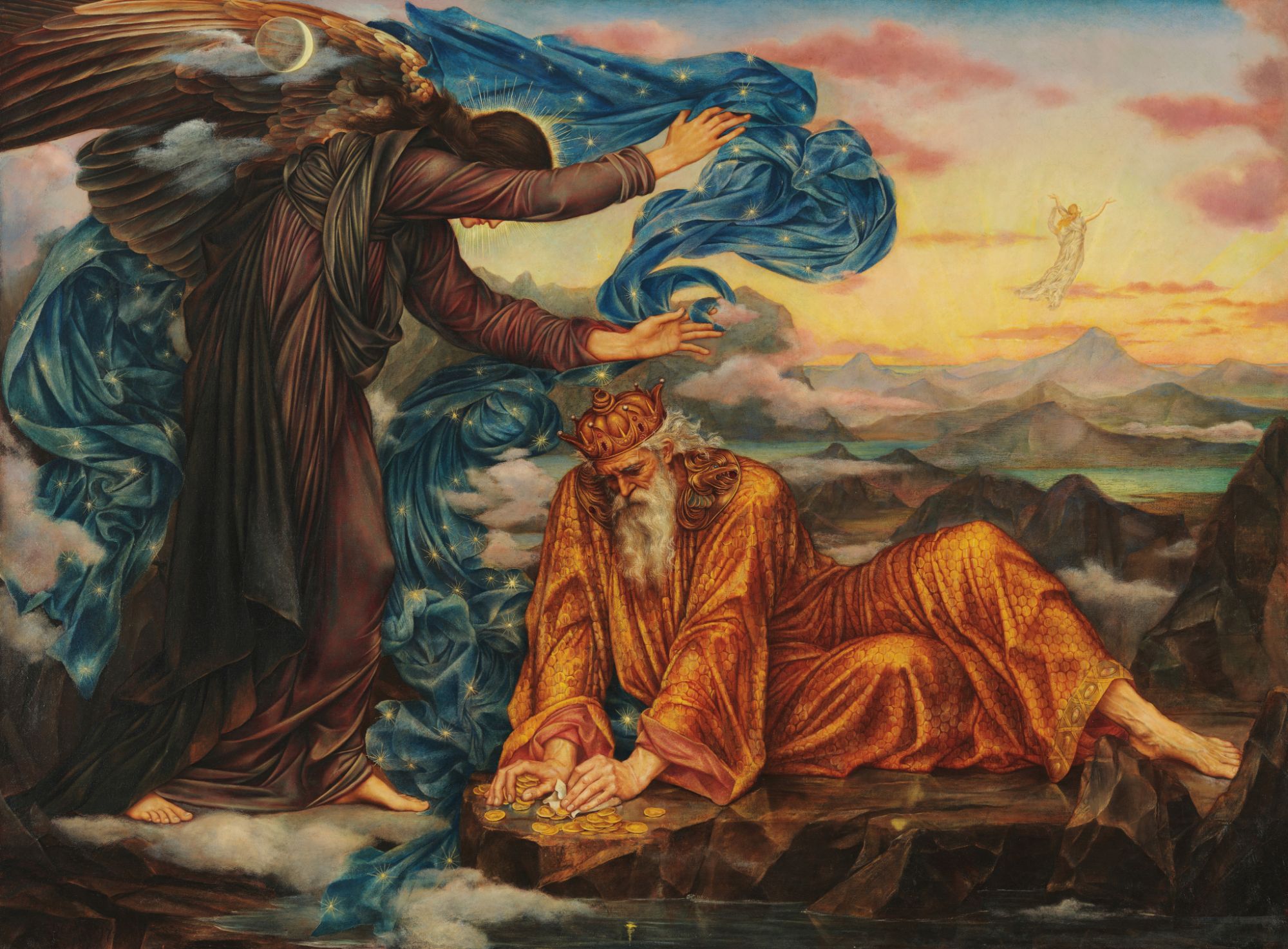
Earthbound (1897)
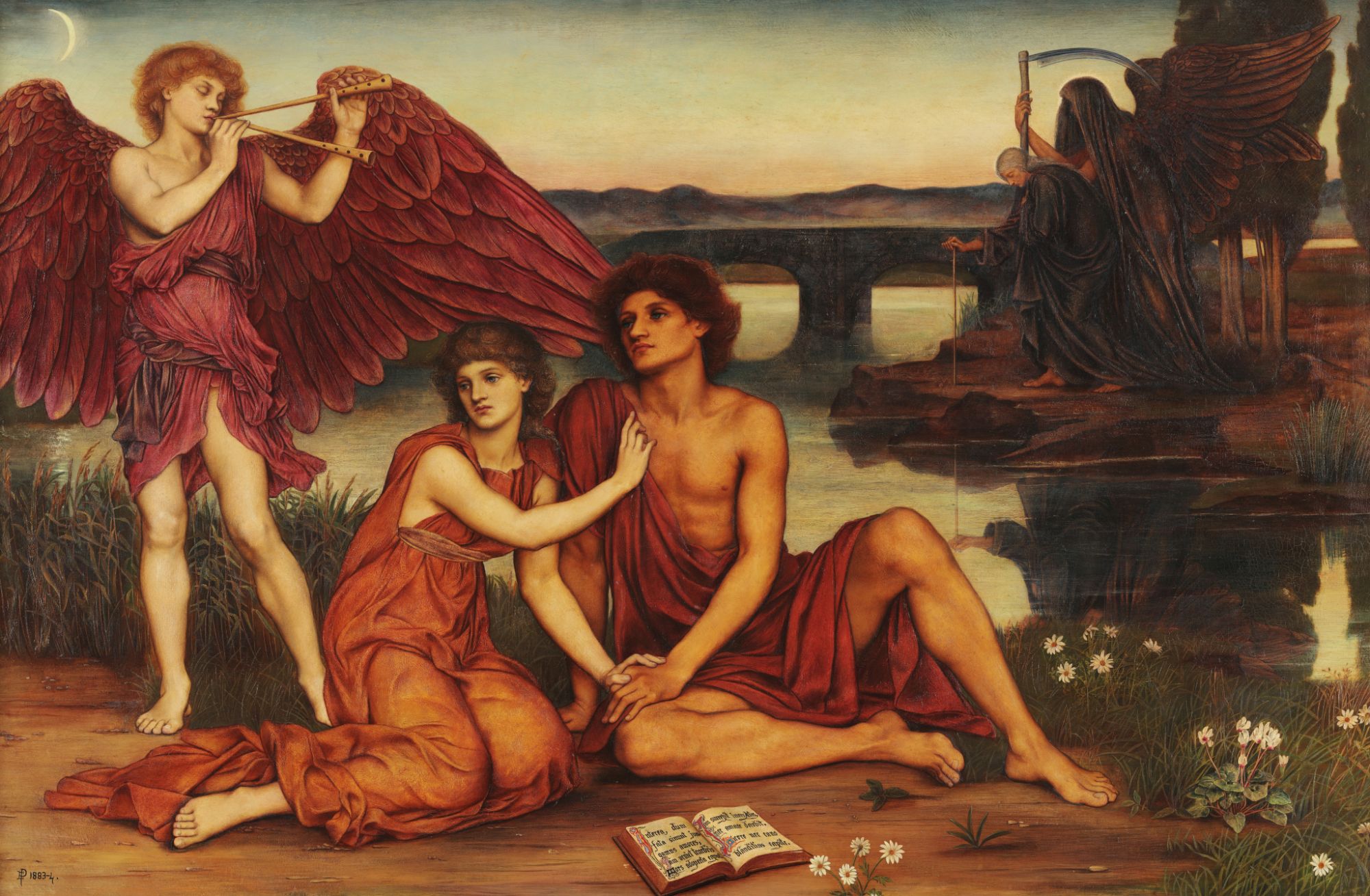
Love’s Passing (1883)
The final picture listed is Love’s Passing, described by the artist as ‘two lovers, seated in the twilight, hear the flutter of love’s wings, and the music of his piping. In the far distance unperceived are two figures of death and Eld.’ This allegorical painting deals with the difficult path of love. One which can seem so sweet in youth, but comes with the ultimate cost of loss and grief.
Events
Save the dates! More information to follow.
Saturday 30 November 2024
Explore different aspects of De Morgan’s artistic journey, with talks covering the influence of Pre-Raphaelite and Renaissance masters, symbolism and mythology, and social concerns. This event includes an exclusive exhibition tour led by Sarah Hardy, Director of the De Morgan Museum, followed by a celebratory reception.
Saturday 8 March 2025
The closing event will explore themes in the exhibition relevant to International Women’s Day 2025.
Painted Dreams: The Art of Evelyn De Morgan, installation view, Wolverhampton Art Gallery, October 2024. Photograph by Patrick Dandy
Wolverhampton Art Gallery
Wolverhampton Art Gallery
Address:
Lichfield Street,
Wolverhampton,
West Midlands,
WV1 1DU,
United Kingdom
Opening Times:
Monday to Saturday: 10:30 AM – 4:30 PM
Sunday: 11:00 AM – 4:00 PM
About:
Wolverhampton Art Gallery houses an extensive collection of art ranging from Victorian and Georgian works to modern and contemporary pieces. It is particularly noted for its impressive collection of Pop Art and its engaging community programmes.
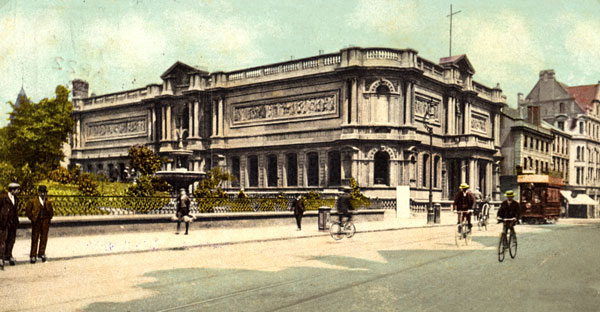
Donate
We rely on your generous support to care for and display this wonderful collection

